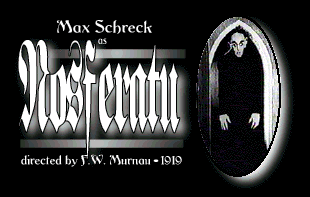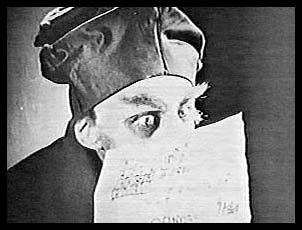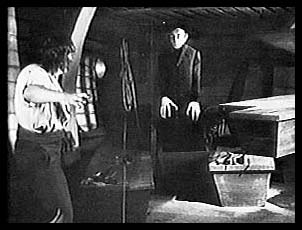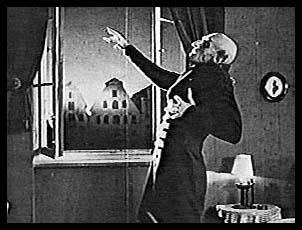

A Prana Film production
Cast: Max Schreck (Count Orlock/Dracula), Alexander Granach (Knock/Renfield), Gustav von Wangenheim (Hutter/Harker), Greta Schroeder (Ellen/Mina), G. H. Schnell (Shipowner), Ruth Landshoff (His Wife) Jon Gottowt (Professor Bulwer), Gustav Botz (Professor Sievers), Max Nemetz (Captain of the "Demeter"), Wolfgang Heinz (Seaman), Albert Vernohr (Seaman), Guido Herzfeld (Innkeeper), Hardy von Francois (Doctor)
It's ironic that the recent film SHADOW OF THE VAMPIRE ended its story before the release of NOSFERATU, because at that point the earlier film assumed an almost supernatural life of its own-refusing to die no matter how many attempts were made to destroy it. Even stranger, its fate paralleled that of a later film made by F. W. Murnau.
NOSFERATU was conceived as the initial offering of a production
company spearheaded by Albin Grau, an artist and architect as
well as an  oddball who dabbled in spiritualism
and the occult. Grau's faith in the supernatural was demonstrated
by his founding of Prana-Film on a paltry 20,000 marks, a pathetic
sum even before the German economy was beset by runaway inflation.
Grau's artistic and mystic aspirations made Bram Stoker's Dracula
a logical choice, but the novel was still protected by copyright.
So he got Henrik Galeen, author of DER GOLEM (1914) and connoisseur
of the fantastic, to write a screenplay which kept the basic story
but jettisoned much of the novel's logic in favor of expressionistic
emotion, and changed all of its names and locations. Grau himself
created a series of atmospheric production sketches to illustrate
the sort of imagery he was after and unwittingly guaranteed himself
a footnote in cinema history by hiring a tyro director named F.
W. Murnau.
oddball who dabbled in spiritualism
and the occult. Grau's faith in the supernatural was demonstrated
by his founding of Prana-Film on a paltry 20,000 marks, a pathetic
sum even before the German economy was beset by runaway inflation.
Grau's artistic and mystic aspirations made Bram Stoker's Dracula
a logical choice, but the novel was still protected by copyright.
So he got Henrik Galeen, author of DER GOLEM (1914) and connoisseur
of the fantastic, to write a screenplay which kept the basic story
but jettisoned much of the novel's logic in favor of expressionistic
emotion, and changed all of its names and locations. Grau himself
created a series of atmospheric production sketches to illustrate
the sort of imagery he was after and unwittingly guaranteed himself
a footnote in cinema history by hiring a tyro director named F.
W. Murnau.
Friederick Wilhelm Plumpe (to give his real name) was, like Galeen (and 99% of the German film industry), a former member of Max Reinhardt's theater group. Although he had directed seven films prior to NOSFERATU, he was not well known outside of the German cinema circle. Indeed, given NOSFERATU's meager budget, it seems likely that its appeal to Murnau was the chance to give full rein to his own aesthetic aspirations and perhaps increase his own stock in the industry. The director's later films show that much of what is loosely termed expressionism should more accurately be termed "Murnau-ism." While there is no doubt he was influenced by expressionism and its more formalistic proponents such as Edvard Munch, there is just as much of the German romantic tradition of Goethe and the fantastic horror sense of the Grimm Brothers. Most of all there is Murnau.
Many of Murnau's and NOSFERATU's innovations were born of budgetary restrictions. Lacking the funds to translate Grau's sketches into representative-and intentionally artificial-sets, Murnau opted instead to shoot the film on location and allow his own sense of composition and chiaroscuro to suggest the unreal imagery. Many of the locations chosen by Murnau are easily recognizable today, including Count Orlock's/Dracula's ruined castle and the salt warehouses across from Ellen's/Mina's bedroom. (Many locations were partially or completely bombed out of existence during World War II.)
Less successful were the rudimentary special effects, which heavily relied on the one crank/one frame camera technique to produce a jerky animation effect, as the vampire drives Hutter/Harker to his castle, and later as Orlock loads his coffins into a wagon. Crude at the time, today these scenes frequently provoke laughter rather than thrills. Somewhat more effective was the use of negative film to show the journey through the "Land of Shadows". (The carriage was painted white so that it would photograph normally against the reversed background.)
Best of all was the vampire's make-up, which became more
rat-like as the picture progressed. In fact, Max Schreck's appearance
is far more  unnerving than Willem Dafoe's in SHADOW
OF THE VAMPIRE, despite the advances in make-up over the past
eighty years. Murnau may not have used a real vampire, but he
did find Schreck, whose name happens to be the German word for
terror. Because this seemed too coincidental, for many years it
was thought to be a pseudonym for Alfred Abel or some other better
known German actor. Later research has proven that Max Schreck
was his real name or at least not one assumed especially for NOSFERATU.
unnerving than Willem Dafoe's in SHADOW
OF THE VAMPIRE, despite the advances in make-up over the past
eighty years. Murnau may not have used a real vampire, but he
did find Schreck, whose name happens to be the German word for
terror. Because this seemed too coincidental, for many years it
was thought to be a pseudonym for Alfred Abel or some other better
known German actor. Later research has proven that Max Schreck
was his real name or at least not one assumed especially for NOSFERATU.
Grau's abilities as an artist may be open to conjecture, but as a producer there is no doubt he was an idiot. He expended his limited resources on ridiculous details of little or no value, such as the contract brought by Hutter to Orlock. Grau labored over the document, filling it with obscure symbols and occult formulae incomprehensible to all but a few of his fellow thaumaturgists. Orlock would have possessed such arcane knowledge, but Hutter would not; nor would there have been any reason to include them in a deed! Worse, Grau can not be excused as being too artistically involved to be concerned about whether his source material might belong to someone else. The fact all names and locales were changed means Grau knew the novel was still protected by copyright and naively figured he could get away with it.
No sooner had this celluloid vampire premiered than a Van Helsing appeared intent on driving a legal stake through its reels. Florence Stoker, the author's widow, had little to sustain her except her income from the only one of her husband's novels currently in print. She immediately tried to file a suit in German court against NOSFERATU's production company, but Grau's mismanagement had already led to bankruptcy. Failing to extract any actual funds, she sought to have the film destroyed. For some reason she didn't seek ownership in order to either sell the film to a distributor or release it herself. The court concurred and ordered the negative and all prints destroyed. Or so the story goes. The fact that at least two different versions have been uncovered in the last few years would indicate that more than one print survived the purge.
Florence Stoker thought she was rid of NOSFERATU, but the film appeared in England almost immediately and the whole thing began all over again. Indeed, this was the pattern for the rest of the decade. In 1929 the film surfaced in America. However, it never gained the attention of a major distributor and the limited showings it received everywhere were always under the auspices of a film society, and for good reason.
It can certainly be said of NOSFERATU that it hints at things to come. In and of itself, NOSFERATU is flawed by its meager budget and primitive effects, although Murnau still makes it interesting and memorable with his angles and compostions, and such creative touches as substituting a gliding shadow for his vampire.
It is a harbinger of what he would accomplish with such
later masterpieces as THE LAST LAUGH (UFA, 1924), FAUST (UFA,
1926), and SUNRISE (Fox, 1927). Interestingly, NOSFERATU was not
the only Murnau film to arise from the ashes of destruction. Following
SUNRISE and FOUR DEVILS (Fox, 1928) he produced CITY GIRL (Fox,
1929), a reversal of SUNRISE with the title character finding
redemption in the country. After its completion, the studio drastically
recut it and turned it into a talkie. This official released version
has been lost for  years, but the film survives
in Murnau's original silent version.
years, but the film survives
in Murnau's original silent version.
It is interesting to consider the result if, when Lon Chaney died, Universal had sacked Browning in favor of Murnau to direct Bela Lugosi in DRACULA. Together with his old cinematographer Karl Freund they might have created the definitive Dracula of the movies
Leonard Maltin's Movie and Video Guide put it succinctly, "Early version of Dracula is brilliantly eerie, full of imaginative touches that none of the later films quite captured. Schreck's vampire is also the ugliest in film history." The latter fact was certainly recognized by the producers of the TV mini-series SALEM'S LOT and the low budget SUBSPECIES series who unhesitatingly patterned their blood-suckers after NOSFERATU.
A 1929 Variety review, written by someone who was unfamiliar with the history of the film, states, "Skillfully mounted and directed, this [is a] symbolical legendary cinema story of reanimated ghosts in a period set about a century or so ago when vampirism was pretty well entrenched in the world's beliefs." The reviewer felt that the titles were handled badly and that "this and Murnau's work [leave] the question open whether this film was made long ago or lately."
"Picture is a shivery melo spilling ghostlike impossibilities from beginning to end. Action details the forages of a nobleman who is dead yet alive, making nighttime raids on human beings and compelling them to become subservient to him by sucking the blood from their necks, often plaguing them to death. His especial delight is a pretty woman."
"Murnau proved his directorial artistry in SUNRISE
for Fox about three years ago, but in this picture he's a master
artisan demonstrating not only a knowledge of the subtler side
of directing but in photography. One shot of the sun cracking
at dawn is an eye-filler. Among others of extremely imaginative
beauty is one which takes in a schooner sailing in a rippling
stream photographed in such a manner that it has the  illusion
of color and an enigmatic weirdness that's more perplexing than
the ghost action of the players."
illusion
of color and an enigmatic weirdness that's more perplexing than
the ghost action of the players."
"His funeral scene in the deserted town street where the bodies of the plague victims are carried in coffins held aloft by straggling pallbearers is unusual to say the least. Empty shattering buildings photographed to suggest the desperate desolation brought on by the vampire is extremely effective symbolism."
"Max Schreck as the vampire is an able pantomimist and works clock-like, his makeup suggesting everything that's goose pimply. He did his worst on every occasion-which was good."
This time it was The New York Times' Mordaunt Hall who didn't get it. "Because of its age and also the extravagant idea, NOSFERATU THE VAMPIRE, a film supposed to have been inspired by the blood-curdling Dracula, is not especially stirring. It is the sort of thing one could watch at midnight without its having much effect upon one's slumbering hours."
"This would-be spine-chiller neglects little in its desire to make somebody or other look around for werewolfs (sic), ghosts or vampires. It was directed by F. W. Murnau, for a German concern called Prana Film Productions. The backgrounds are often quite effective, but most of it seems like cardboard puppets doing all they can to be horrible on papier-mache settings."
"Mr. Murnau has made full use of coffins and rats. Shadows are employed to add to the horror of the chief figure, who has extra joints stuck on to the ends of his fingers. Max Schreck's movements as Nosferatu are too deliberate to be lifelike."
To this last comment we can only say, wasn't that the point?
copyright 2001 by Dave Snyder and Steve
Haynes. All rights reserved.
Return to
"Nosferatu" page